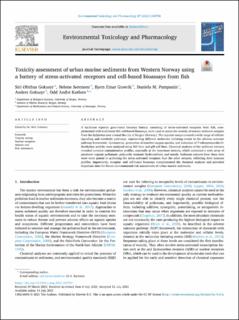| dc.contributor.author | Goksøyr, Siri Øfsthus | |
| dc.contributor.author | Sørensen, Helene | |
| dc.contributor.author | Grøsvik, Bjørn Einar | |
| dc.contributor.author | Pampanin, Daniela Maria | |
| dc.contributor.author | Goksøyr, Anders | |
| dc.contributor.author | Karlsen, Odd André | |
| dc.date.accessioned | 2022-01-06T09:41:21Z | |
| dc.date.available | 2022-01-06T09:41:21Z | |
| dc.date.created | 2021-12-08T14:05:38Z | |
| dc.date.issued | 2021 | |
| dc.identifier.citation | Environmental Toxicology and Pharmacology. 2021, 87:103704 1-10. | en_US |
| dc.identifier.issn | 1382-6689 | |
| dc.identifier.uri | https://hdl.handle.net/11250/2836308 | |
| dc.description.abstract | A luciferase reporter gene-based bioassay battery consisting of stress-activated receptors from fish, complemented with traditional fish cell-based bioassays, were used to assess the toxicity of marine sediment samples from the Byfjorden area around the city of Bergen (Norway). The reporter assays covered a wide range of cellular signalling and metabolic pathways, representing different molecular initiating events in the adverse outcome pathway framework. Cytotoxicity, generation of reactive oxygen-species, and induction of 7-ethoxyresorufin-O-deethylase activity were analysed using fish liver and gill cell lines. Chemical analyses of the sediment extracts revealed complex contamination profiles, especially at the innermost stations, which contained a wide array of persistent organic pollutants, polycyclic aromatic hydrocarbons, and metals. Sediment extracts from these sites were more potent in activating the stress-activated receptors than the other extracts, reflecting their toxicant profiles. Importantly, receptor- and cell-based bioassays complemented the chemical analyses and provided important data for future environmental risk assessments of urban marine sediments. | en_US |
| dc.language.iso | eng | en_US |
| dc.title | Toxicity assessment of urban marine sediments from Western Norway using a battery of stress-activated receptors and cell-based bioassays from fish | en_US |
| dc.type | Peer reviewed | en_US |
| dc.type | Journal article | en_US |
| dc.description.version | publishedVersion | en_US |
| dc.source.pagenumber | 1-10 | en_US |
| dc.source.volume | 87:103704 | en_US |
| dc.source.journal | Environmental Toxicology and Pharmacology | en_US |
| dc.identifier.doi | 10.1016/j.etap.2021.103704 | |
| dc.identifier.cristin | 1966255 | |
| dc.relation.project | Norges forskningsråd: 248840 | en_US |
| dc.relation.project | Norges forskningsråd: 244564 | en_US |
| dc.relation.project | Havforskningsinstituttet: 15445 | en_US |
| cristin.ispublished | true | |
| cristin.fulltext | original | |
| cristin.qualitycode | 1 | |
